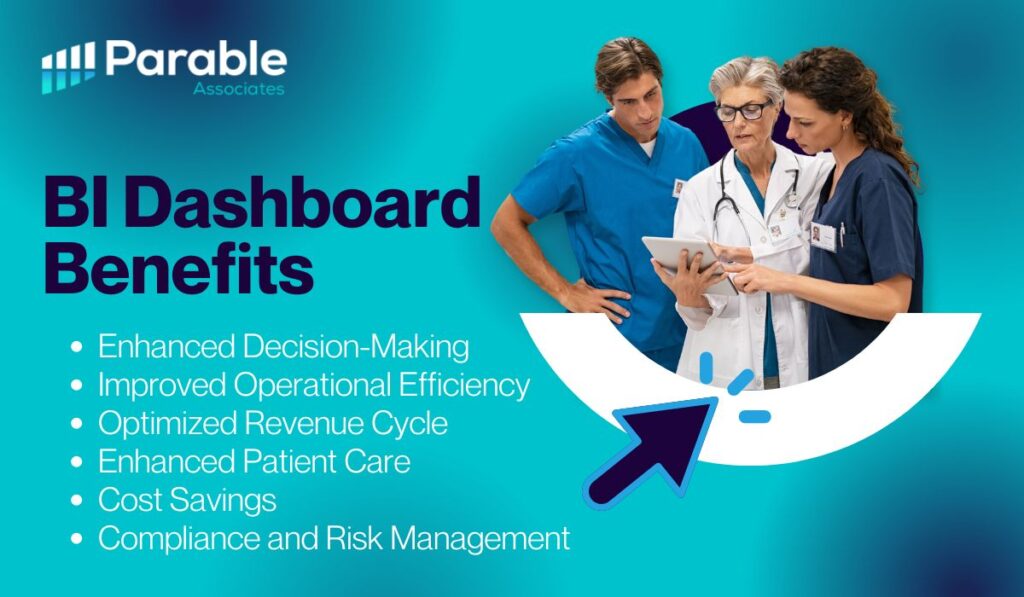As healthcare becomes more complex and data-reliant, business intelligence dashboards have become a critical tool for medical practices seeking to optimize operations, enhance decision-making, and improve patient care. They provide an interactive digital interface that gathers data from multiple sources, organizes it, and presents it in a visual format—such as charts, graphs, or tables—for easy interpretation.
However, can implementing business intelligence dashboards truly benefit your practice? Exploring their features, advantages, and considerations for implementation will enable you to better understand how these tools can transform your healthcare practice.

What Are Business Intelligence Dashboards?
Business intelligence (BI) dashboards are centralized platforms designed to make complex data more accessible and actionable. They collect information from various systems—such as electronic health records (EHRs), billing software, and scheduling tools—and present it in a visually intuitive way. These highly customizable dashboards allow healthcare providers to tailor the interface to their unique needs and priorities.
Key features of business intelligence dashboards include:
- Data visualization: Turning raw data into easy-to-read charts, graphs, and tables.
- Real-time monitoring: Providing up-to-the-minute updates for informed decision-making.
- Predictive analytics: Using historical data to forecast future outcomes.
- KPI tracking: Monitoring key performance indicators specific to healthcare, such as patient wait times or billing cycle efficiency.
By presenting data in a way that is easy to interpret, business intelligence dashboards help healthcare practices address challenges, streamline processes, and improve both clinical and operational outcomes.

Benefits of Business Intelligence Dashboards for Medical Practices
Enhanced Decision-Making
Access to real-time data is one of the most significant benefits of business intelligence dashboards. Using the instant insights the dashboards provide, healthcare providers can make data-driven decisions quickly and confidently. For example, a dashboard might reveal that certain times of the day experience higher patient traffic, enabling practices to adjust staffing levels accordingly. This ensures that resources are allocated efficiently and that patient care is not compromised during peak periods.
Dashboards also allow providers to identify trends over time, such as recurring issues with patient no-shows or delays in billing. These insights can inform long-term strategies to address these challenges and improve overall performance.
Improved Operational Efficiency
Business intelligence dashboards are powerful tools for streamlining workflows and eliminating inefficiencies. Automating tasks such as data entry and report generation can free up valuable time for staff to focus on patient care.
Dashboards can also highlight workflow bottlenecks, such as excessive delays in patient check-ins or scheduling conflicts. Once these bottlenecks are identified, practices can implement targeted solutions to resolve them, ensuring smoother operations and improved productivity.
For example, a dashboard might reveal that certain departments consistently fall behind on appointment scheduling. With this information, the practice can reassign resources or introduce automation tools to improve scheduling efficiency.
Optimized Revenue Cycle Management
Managing a healthcare practice’s revenue cycle can be complex, but business intelligence dashboards simplify the process by providing real-time visibility into billing and payment workflows. Dashboards can track claims submissions, identify delays, and highlight patterns in denied claims, enabling practices to take corrective action quickly.
By automating revenue cycle monitoring, dashboards reduce administrative errors and improve cash flow. This is especially valuable for practices looking to maximize their financial performance while minimizing the risk of disruptions caused by payment delays or inaccuracies.
Compliance and Risk Management
Healthcare practices are subject to stringent regulations, including HIPAA and other data privacy laws. Business intelligence dashboards play a crucial role in ensuring compliance by providing audit trails, monitoring for anomalies, and maintaining robust data security features.
Dashboards can identify irregularities in billing codes that might trigger audits or penalties. By addressing these issues proactively, practices can avoid costly fines and maintain their reputation for ethical operations.
Dashboards also support risk management by tracking potential vulnerabilities, such as outdated software or unauthorized access attempts, ensuring that practices stay ahead of compliance requirements.
Enhanced Patient Care
At the heart of every healthcare practice is the goal of providing exceptional patient care. Business intelligence dashboards contribute to this goal by offering insights into patient trends, treatment outcomes, and care delivery processes.
Dashboards can track patient metrics such as follow-up appointment rates, treatment adherence, and readmission rates. Practices can use this data to identify high-risk patients and implement preventive measures, improving overall patient outcomes.
Additionally, by optimizing workflows and resource allocation, dashboards enable providers to spend more time on direct patient care, enhancing the patient experience.
Cost Savings
Implementing business intelligence dashboards can lead to significant cost savings by reducing administrative overhead and preventing costly errors. Task automation as report generation and claims tracking eliminates the need for manual processes, saving time and resources.
Furthermore, dashboards provide financial forecasting tools that help practices plan for future expenses and allocate budgets more effectively. By identifying inefficiencies and areas for cost reduction, dashboards contribute to a more financially sustainable practice.

Common Implementation Challenges
Data Integration Issues
One of the biggest challenges in implementing business intelligence dashboards is integrating data from multiple sources. Healthcare practices often rely on various systems—such as EHRs, billing software, and scheduling tools—that may not be compatible with one another. Customization and technical expertise are often required to ensure seamless data integration.
Training and Adoption
Even the most advanced business intelligence dashboards require proper training for staff to use them effectively. Practices must invest in training programs to ensure everyone understands how to navigate the dashboard, interpret data, and apply insights to their workflows. Otherwise, the full benefits of the dashboard may go unrealized.
Upfront Costs
While business intelligence dashboards provide long-term value, the initial investment in software, customization, and training can be significant. However, the return on investment—through improved efficiency, better decision-making, and enhanced patient care—typically outweighs these upfront costs over time.
Is a Business Intelligence Dashboard Right for Your Practice?
Deciding whether to implement a business intelligence dashboard depends on several factors, including the size of your practice, the complexity of your data, and your operational challenges.
For smaller practices, dashboards can simplify data management and provide valuable insights to drive growth. Larger organizations, on the other hand, benefit from advanced analytics and scalability that support their expansive data needs.
Customization is a critical consideration. Off-the-shelf dashboards are often insufficient to address the unique requirements of healthcare practices. A tailored approach ensures that the dashboard aligns with the specific goals of your practice.

Choosing the Right Solution: Parable Associates
Selecting the right business intelligence dashboard begins with evaluating its features and capabilities. Look for a platform that offers:
- User-friendliness: Intuitive interfaces that staff can easily navigate.
- Scalability: The ability to grow and adapt with your practice.
- Customization: Tools tailored to your specific needs and priorities.
When it comes to business intelligence dashboards, choosing the right partner is as important as selecting the tool itself. At Parable Associates, we specialize in designing customized BI solutions that address the unique challenges of healthcare practices.
With extensive experience in platforms like Experity and ModMed, we ensure seamless data integration, robust analytics, and a user-friendly interface that empowers your team to make data-driven decisions. Our approach goes beyond implementation—we provide comprehensive training and ongoing support to ensure your dashboard delivers value over time.
Parable Associates also prioritizes compliance and security, ensuring that your dashboard meets all industry regulations and protects sensitive patient data. With our tailored solutions, your practice can achieve improved efficiency, enhanced patient care, and sustainable financial growth.
Ready to unlock the full potential of your practice? Schedule a discovery call with Parable Associates today and see how business intelligence dashboards can transform your operations.
Business Intelligence Dashboard FAQs
A business intelligence dashboard is a digital tool that collects data from multiple healthcare systems, such as EHRs, billing software, and scheduling tools, and presents it in a visually intuitive format. These dashboards allow medical practices to monitor key metrics, make data-driven decisions, and streamline operations.
Business intelligence dashboards provide real-time data visualization, allowing healthcare providers to quickly identify trends, monitor performance, and address challenges. This leads to informed decisions, such as adjusting staffing during peak hours or improving billing efficiency. Lorem ipsum dolor sit amet, consectetur adipiscing elit, sed do eiusmod tempor incididunt ut labore et dolore magna aliqua. Ut enim ad minim veniam, quis nostrud exercitation ullamco laboris nisi ut aliquip ex ea commodo consequat.
Data visualization: Easy-to-read charts, graphs, and tables.
Real-time monitoring: Up-to-the-minute data updates.
Predictive analytics: Using past data to forecast future outcomes.
KPI tracking: Monitoring metrics like patient wait times and billing cycles.
Benefits include improved operational efficiency, enhanced patient care, optimized revenue cycle management, better compliance with regulations, and significant cost savings through reduced administrative tasks and error prevention.
Yes, common challenges include:
Data integration: Combining information from incompatible systems.
Training and adoption: Ensuring staff understand and use the tool effectively.
Upfront costs: Investing in software, customization, and training, which often pays off in the long term.
Yes, business intelligence dashboards can simplify data management and provide actionable insights, making them valuable for both small and large practices. Smaller practices can benefit from tailored solutions to address specific operational challenges and drive growth.

